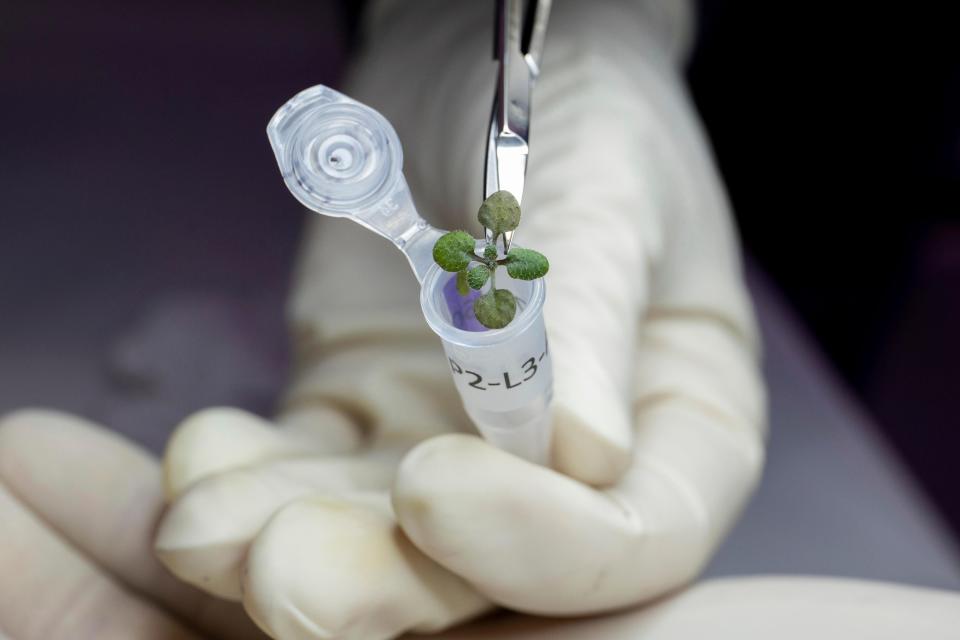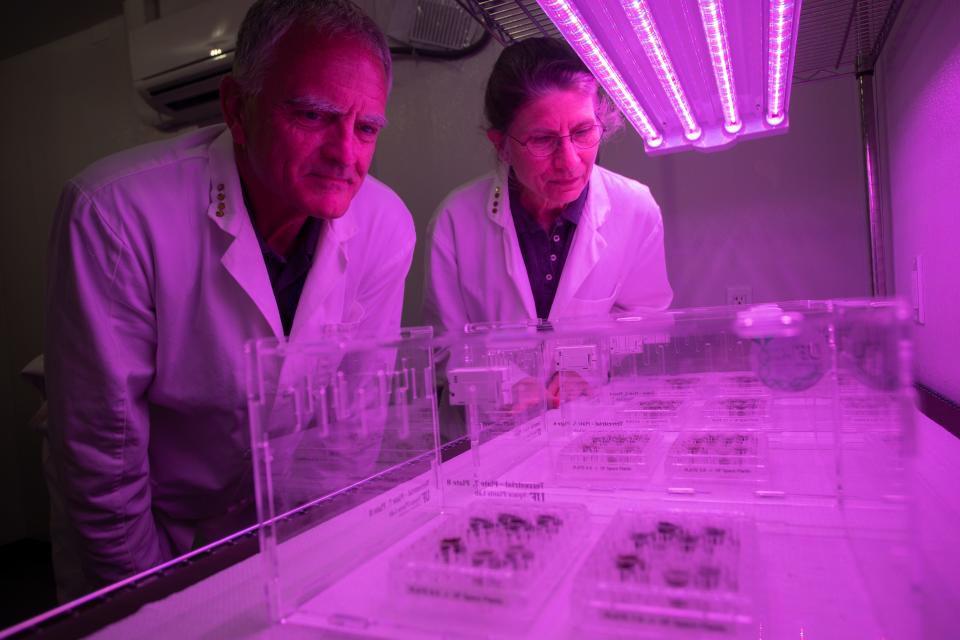UF/IFAS research shows that plants are able to grow in lunar soil
Humans are once again headed to the moon. This return to the moon means we will, for the first time, witness humans not only visiting but living and working on the moon. We will witness our civilization literally moving off the surface of the Earth.
The lunar landings of 1969 through 1972 were short stays. The demands of getting to and returning from the moon with the technology of that era meant that all elements of life support had to be carried to the lunar surface. There was no chance for resupply — and, certainly, no chance to live off the land.
This time could be very different. One big goal of NASA’s Artemis program is a more sustained human presence on the lunar surface, seen as a prelude to a mission to Mars. NASA is aggressively planning lunar habitats capable of that sustained presence.
To accomplish that shift in spirit and extension of time on the moon, we need to think well beyond the notion that we can take all our supplies with us, like backpackers in the wilderness. Instead, we need to think like settlers, going to a new location to stay. We need to take seeds with us to grow our own food.
And in an experiment in the Space Plants Lab at the University of Florida, we have just shown that farming with lunar soil is possible, detailed in our study just published in Communications Biology.

For the first time, seeds were sown directly in lunar regolith — the “soil” of the moon, which comprises the dust, broken down rocks and other materials present on the moon’s surface — using samples provided by NASA from Apollo 11, 12 and 17. The seeds were watered and fertilized, then given the chance to grow in a room that might be similar to a lunar plant growth facility.
The seeds germinated. The plants grew. Their roots, with varying degrees of success, worked their way into the lunar regolith and supported the production of stems and leaves.
Not every plant in every Apollo sample grew well, and all of the plants demonstrated signs of stress. Indeed, molecular analysis indicated that the plants considered growing in lunar soils to be somewhat similar to growing in salty, metal-rich soils on the Earth. Perhaps remarkably, plants can overcome the difficulty of growing in lunar soils by specifically altering their metabolism to deal with the harshness of the lunar regolith.
During the Apollo era, plant experiments in the Lunar Receiving Laboratory at Johnson Space Center helped prove that lunar regolith was not pathogenic to terrestrial life.
However, during those initial experiments, plants had never actually been grown in lunar soils — so we have had no clue as to whether lunar agriculture is possible. And given the decidedly harsh physical characteristics and chemical reactivity of lunar regolith, the challenge to terrestrial plants could be very real, as there is no evolutionary wherewithal in plants that would lead science to expect them to be capable of growing in lunar soils.
And so we were filled with wonder as we handled these samples, collected by Neil Armstrong, Buzz Aldrin, Pete Conrad, Alan Bean, Gene Cernan, Harrison Schmidt and the other moonwalkers of the 1960s and 1970s. Seeing the seeds sprout was awe-inspiring, knowing that our research may one day help astronauts grow plants as a source of food and oxygen during deep-space missions and long stays on the moon.
Agriculture has always played a major role in the movement of human civilizations, mostly to supply reliable sources of food and fiber. Plants also have long been integral to space exploration plans because plants recycle water and fix carbon dioxide while producing carbohydrates and oxygen. Plants are the source of our food and breathable air here on Earth, so it makes sense that they would be part of our life-support thinking as we leave the surface of the Earth.
NASA is not alone in such plans. SpaceX is similarly pursuing an agenda that points toward a long-term human presence on Mars while supporting lunar activities to learn how to live on Mars. So the spirit of human exploration of space in general, and the moon in particular, is shifting from that of a purely exploration visit toward a sustained habitation — a movement of human civilization.
Over the past five decades, continuing investments in scientific endeavors -- we are among scientists who have sent experiments on space shuttles, on rockets to the International Space Station and on suborbital flights with Blue Origin and Virgin Galactic -- have sought to answer the question of how to make human habitation possible beyond Earth.

We now know, in a very real and practical way, that lunar agriculture is possible. We will have to provide shelter, water and nutrients, but the soil is already there and we can learn to farm on the moon.
Samples returned from the moon more than 50 years ago, during one of the greatest scientific explorations in history, provided keen insights into the birth of the moon and the development of the solar system. Now those same samples support the research that will take us back to there to explore — but not just to visit. We can go there to stay a while.
Robert Ferl is a distinguished professor of horticultural sciences in UF’s Institute of Food and Agricultural Sciences (UF/IFAS) and assistant vice president for UF Research. Anna-Lisa Paul is a professor of horticultural sciences in UF/IFAS and director of the UF Interdisciplinary Center for Biotechnology Research. This commentary first appeared in The Hill.
Join the conversation
Share your opinions by sending a letter to the editor (up to 200 words) to letters@gainesville.com. Letters must include the writer's full name and city of residence. Additional guidelines for submitting letters and longer guest columns can be found at bit.ly/sunopinionguidelines.
Journalism matters. Your support matters.
Get a digital subscription to the Gainesville Sun. Includes must-see content on Gainesville.com and Gatorsports.com, breaking news and updates on all your devices, and access to the eEdition. Visit www.gainesville.com/subscribenow to sign up.
This article originally appeared on The Gainesville Sun: Robert Ferl and Anna-Lisa Paul: UF researching growing plants on moon

